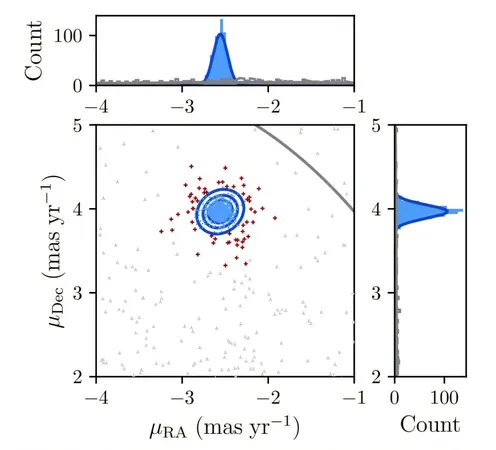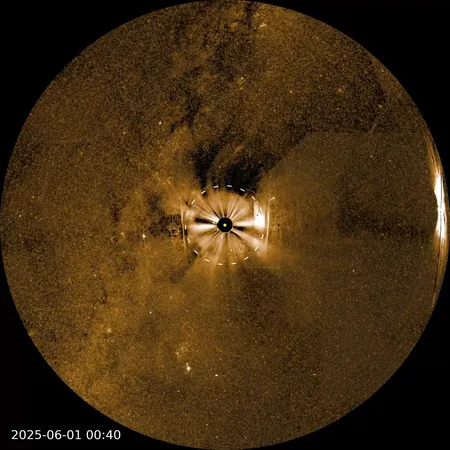
Discovery of Stellar Secrets: New Insights into Open Cluster NGC 2506!
2024-10-31
Author: Jia
Introduction
Astrophysicists from the University of Wisconsin–Madison, in collaboration with the Harvard–Smithsonian Center for Astrophysics, have turned their focus on the intriguing Galactic open cluster NGC 2506 as part of their comprehensive WIYN Open Cluster Study. The findings, published in The Astronomical Journal on October 14, have opened up new avenues for understanding the characteristics of this cluster and its stellar constituents.
Significance of Open Clusters
Open clusters, which are groups of stars formed from the same giant molecular cloud and loosely bound by gravity, play a key role in understanding our galaxy's formation and evolution. Over 1,000 of these clusters have been identified within the Milky Way, but researchers are on an ongoing quest to discover more, hoping to unlock the secrets of stellar evolution across various environments.
Characteristics of NGC 2506
Located approximately 12,700 light-years away from Earth, NGC 2506—also known as Caldwell 54—boasts a rich population of stars and is characterized as being mildly elongated. This particular cluster is deemed metal-poor and is estimated to be about 2 billion years old, placing it in the category of intermediate-age clusters. Its significant stellar population makes NGC 2506 an exceptional case study for astronomers interested in the processes of star formation and evolution.
Research Methodology
Under the guidance of Evan Linck from the University of Wisconsin–Madison, the research team conducted a detailed radial-velocity survey using the WIYN Observatory's 3.5-meter telescope. By examining over 2,400 stars within NGC 2506, they successfully identified 320 stars as members of the cluster based on proper motion and radial velocity measurements.
Findings and Observations
The results revealed fascinating data: the mean radial velocity of NGC 2506 is approximately 84.29 km/s, with a radial velocity dispersion of just 0.54 km/s. Additionally, the cluster's core radius is about 8 light-years, while its tidal radius extends to roughly 145 light-years, indicating a well-defined gravitational structure. The estimated virial mass of NGC 2506 is around 3,400 solar masses, highlighting its substantial stellar content.
Binary Stars and Interactions
Notably, the research dive also discovered and derived orbital solutions for 60 binary stars within the cluster, with orbital periods ranging from just 1 day to as much as 7,580 days. A significant finding is that about 35% of the upper main sequence stars possess a binary companion—important for understanding stellar interactions and exchanges within clusters. Moreover, it was revealed that at least 64% of the known blue straggler stars in NGC 2506 exist in binary systems, emphasizing their potential origins in stellar interactions.
Conclusion
As researchers continue to dissect the complexities of NGC 2506, this study shines a light on the secrets our galaxy holds and invites further exploration into the captivating world of stellar clusters. Such breakthroughs set the stage for future inquiries into the formation processes that shaped our cosmic neighborhood! What other wonders do the stars conceal? Only time will tell!




 Brasil (PT)
Brasil (PT)
 Canada (EN)
Canada (EN)
 Chile (ES)
Chile (ES)
 Česko (CS)
Česko (CS)
 대한민국 (KO)
대한민국 (KO)
 España (ES)
España (ES)
 France (FR)
France (FR)
 Hong Kong (EN)
Hong Kong (EN)
 Italia (IT)
Italia (IT)
 日本 (JA)
日本 (JA)
 Magyarország (HU)
Magyarország (HU)
 Norge (NO)
Norge (NO)
 Polska (PL)
Polska (PL)
 Schweiz (DE)
Schweiz (DE)
 Singapore (EN)
Singapore (EN)
 Sverige (SV)
Sverige (SV)
 Suomi (FI)
Suomi (FI)
 Türkiye (TR)
Türkiye (TR)
 الإمارات العربية المتحدة (AR)
الإمارات العربية المتحدة (AR)